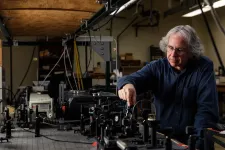Landmark study details sequencing of 64 full human genomes to better capture genetic diversity
Scott Devine, PhD 64 human genomes sequenced will serve as new reference for genetic variation and predisposition to human diseases
2021-02-25
(Press-News.org) Researchers at the University of Maryland School of Medicine (UMSOM) co-authored a study, published today in the journal Science, that details the sequencing of 64 full human genomes. This reference data includes individuals from around the world and better captures the genetic diversity of the human species. Among other applications, the work will enable population-specific studies on genetic predispositions to human diseases as well as the discovery of more complex forms of genetic variation.
Twenty years ago this month, the International Human Genome Sequencing Consortium announced the first draft of the human genome reference sequence. The Human Genome Project, as it was called, required 11 years of work and involved more than 1000 scientists from 40 countries. This reference, however, did not represent a single individual, but instead was a composite of humans that could not accurately capture the complexity of human genetic variation.
Building on this, scientists have conducted several sequencing projects over the last 20 years to identify and catalog genetic differences between an individual and the reference genome. Those differences usually focused on small single base changes and missed larger genetic alterations. Current technologies now are beginning to detect and characterize larger differences - called structural variants - such as insertions of new genetic material. Structural variants are more likely than smaller genetic differences to interfere with gene function.
The new finding in Science announced a new and significantly more comprehensive reference dataset that was obtained using a combination of advanced sequencing and mapping technologies. The new reference dataset reflects 64 assembled human genomes, representing 25 different human populations from across the globe. Importantly, each of the genomes was assembled without guidance from the first human genome composite. As a result, the new dataset better captures genetic differences from different human populations.
"We've entered a new era in genomics where whole human genomes can be sequenced with exciting new technologies that provide more substantial and accurate reads of the DNA bases," said study co-author Scott Devine, PhD, Associate Professor of Medicine at UMSOM and faculty member of IGS. "This is allowing researchers to study areas of the genome that previously were not accessible but are relevant to human traits and diseases."
Institute of Genome Science (IGS)'s Genome Resource Center (GRC) was one of three sequencing centers, along with Jackson Labs and the University of Washington, that generated the data using a new sequencing technology that was developed recently by Pacific Biosciences. The GRC was one of only five early access centers that was asked to test the new platform.
Dr. Devine helped to lead the sequencing efforts for this study and also led the sub-group of authors who discovered the presence of "mobile elements" (i.e., pieces of DNA that can move around and get inserted into other areas of the genome). Other members of the Institute for Genome Sciences (IGS) at the University of Maryland School of Medicine are among the 65 co-authors. Luke Tallon, PhD, Scientific Director of the Genomic Resource Center, worked with Dr. Devine to generate one of the first human genome sequences on the Pacific Bioscences platform that was contributed to this study. Nelson Chuang, a graduate student in Dr. Devine's lab also contributed to the project.
"The landmark new research demonstrates a giant step forward in our understanding of the underpinnings of genetically-driven health conditions," said E. Albert Reece, MD, PhD, MBA, Executive Vice President for Medical Affairs, UM Baltimore, and the John Z. and Akiko K. Bowers Distinguished Professor and Dean, University of Maryland School of Medicine. "This advance will hopefully fuel future studies aimed at understanding the impact of human genome variation on human diseases."
INFORMATION:
About the University of Maryland School of Medicine
Now in its third century, the University of Maryland School of Medicine was chartered in 1807 as the first public medical school in the United States. It continues today as one of the fastest growing, top-tier biomedical research enterprises in the world -- with 45 academic departments, centers, institutes, and programs; and a faculty of more than 3,000 physicians, scientists, and allied health professionals, including members of the National Academy of Medicine and the National Academy of Sciences, and a distinguished two-time winner of the Albert E. Lasker Award in Medical Research. With an operating budget of more than $1.2 billion, the School of Medicine works closely in partnership with the University of Maryland Medical Center and Medical System to provide research-intensive, academic and clinically based care for nearly 2 million patients each year. The School of Medicine has more than $563 million in extramural funding, with most of its academic departments highly ranked among all medical schools in the nation in research funding. As one of the seven professional schools that make up the University of Maryland, Baltimore campus, the School of Medicine has a total population of nearly 9,000 faculty and staff, including 2,500 student trainees, residents, and fellows. The combined School of Medicine and Medical System ("University of Maryland Medicine") has an annual budget of nearly $6 billion and an economic impact more than $15 billion on the state and local community. The School of Medicine, which ranks as the 8th highest among public medical schools in research productivity, is an innovator in translational medicine, with 600 active patents and 24 start-up companies. The School of Medicine works locally, nationally, and globally, with research and treatment facilities in 36 countries around the world. Visit medschool.umaryland.edu
[Attachments] See images for this press release:

ELSE PRESS RELEASES FROM THIS DATE:
2021-02-25
Psychologists have long found that people behave differently than when they learn of peers' actions. A new study by computer scientists found that when individuals in an experiment about autonomous vehicles were informed that their peers were more likely to sacrifice their own safety to program their vehicle to hit a wall rather than hit pedestrians who were at risk, the percentage of individuals willing to sacrifice their own safety increased by approximately two-thirds.
As computer scientists train machines to act as people's agents in all sorts of situations, the study's authors indicate that the social component of decision-making is often overlooked. This could be of great consequence, note the paper's authors who show that the trolly problem -long shown to be ...
2021-02-25
States regularly use administrative records, such as motor-vehicle data, in determining whether people have moved to prune their voter rolls. A Yale-led study of this process in Wisconsin shows that a significant percentage of registered voters are incorrectly identified as having changed addresses, potentially endangering their right to vote.
The study, published in the journal Science Advances, found that at least 4% of people listed as suspected "movers" cast ballots in 2018 elections using addresses that were wrongly flagged as out of date. Minority voters were twice as likely as white voters to cast their ...
2021-02-25
The COVID-19 virus holds some mysteries. Scientists remain in the dark on aspects of how it fuses and enters the host cell; how it assembles itself; and how it buds off the host cell.
Computational modeling combined with experimental data provides insights into these behaviors. But modeling over meaningful timescales of the pandemic-causing SARS-CoV-2 virus has so far been limited to just its pieces like the spike protein, a target for the current round of vaccines.
A new multiscale coarse-grained model of the complete SARS-CoV-2 virion, its core genetic material and virion shell, has been developed for the first time using supercomputers. The model offers ...
2021-02-25
Litter is not only a problem on Earth. According to NASA, there are currently millions of pieces of space junk in the range of altitudes from 200 to 2,000 kilometers above the Earth's surface, which is known as low Earth orbit (LEO). Most of the junk is comprised of objects created by humans, like pieces of old spacecraft or defunct satellites. This space debris can reach speeds of up to 18,000 miles per hour, posing a major danger to the 2,612 satellites that currently operate at LEO. Without effective tools for tracking space debris, parts of LEO may even become too hazardous for satellites.
In a paper publishing today in the SIAM Journal on Imaging Sciences, Matan Leibovich (New York University), George Papanicolaou (Stanford University), and Chrysoula Tsogka (University of California, ...
2021-02-25
The unprecedented cost of the 2018 Kilauea eruption in Hawai'i reflects the intersection of distinct physical and social phenomena: infrequent, highly destructive eruptions, and atypically high population growth, according to a new study published in Nature Communications and led by University of Hawai'i at Mānoa researchers.
It has long been recognized that areas in Puna, Hawai'i, are at high risk from lava flows. This ensured that land values were lower in Puna--which lies within the three highest risk lava hazard zones 1, 2 and 3--which actively promoted rapid population ...
2021-02-25
Our body consists of 100 trillion cells that communicate with each other, receive signals from the outside world and react to them. A central role in this communication network is attributed to receiver proteins, called receptors, which are anchored at the cell membrane. There, they receive and transmit signals to the inside of the cell, where a cell reaction is triggered.
In humans, G protein-coupled receptors (GPC receptors) represent the largest group of these receptor molecules, with around 700 different types. The research of the Frankfurt and Leipzig scientists focused on a GPC receptor that serves as a receptor for the ...
2021-02-25
Timothy Callaghan, PhD, and Alva Ferdinand, DrPH, JD, from the Southwest Rural Health Research Center at Texas A&M University School of Public Health, joined colleagues in the first national study of how often people in urban and rural areas in the United States follow COVID-19 guidelines. These include public health best practices like wearing masks in public, sanitizing homes and work areas, maintaining physical distancing, working from home and avoiding dining in restaurants or bars.
The research team used a survey of 5,009 U.S. adults that closely matched the makeup of the country's population as a whole. The survey asked how often participants followed COVID-19 prevention recommendations and collected data on political ideology, perceived risk ...
2021-02-25
ITHACA, N.Y. - A team from Cornell University's Environmental Systems Lab, led by recent graduate Allison Bernett, has put forth a new framework for injecting as much information as possible into the pre-design and early design phases of a project, potentially saving architects and design teams time and money down the road.
"(Our framework) allows designers to understand the full environmental impact of their building," said Bernett, corresponding author of "Sustainability Evaluation for Early Design (SEED) Framework for Energy Use, Embodied Carbon, Cost, and Daylighting Assessment" which published Jan. 10 in the Journal of ...
2021-02-25
WEST LAFAYETTE, Ind. -- Doppler radar improves lives by peeking inside air masses to predict the weather. A Purdue University team is using similar technology to look inside living cells, introducing a method to detect pathogens and treat infections in ways that scientists never have before.
In a new study, the team used Doppler to sneak a peek inside cells and track their metabolic activity in real time, without having to wait for cultures to grow. Using this ability, the researchers can test microbes found in food, water, and other environments to see if they are pathogens, or help them identify the right medicine to treat antibiotic-resistant bacteria.
David Nolte, Purdue's Edward ...
2021-02-25
HOUSTON - (Feb. 25, 2021) - Low-income livestock farmers in developing countries are often faced with a difficult dilemma: protect their animals from endangered predators, or spare the threatened species at the expense of their livestock and livelihood.
A new paper by Rice University economist Ted Loch-Temzelides examines such circumstances faced by farmers in Pakistan. "Conservation, risk aversion, and livestock insurance: The case of the snow leopard" outlines a plan under which farmers can protect themselves from crippling financial losses while ...
LAST 30 PRESS RELEASES:
[Press-News.org] Landmark study details sequencing of 64 full human genomes to better capture genetic diversity
Scott Devine, PhD 64 human genomes sequenced will serve as new reference for genetic variation and predisposition to human diseases



